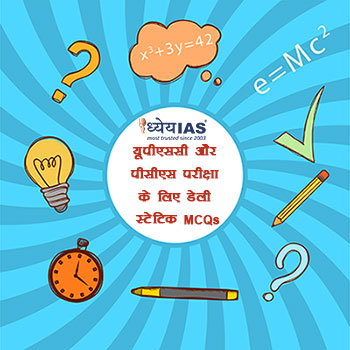Daily Static MCQs Quiz for UPSC, IAS, UPPSC/UPPCS, MPPSC. BPSC, RPSC & All State PSC Exams
Subject : History
1. Consider the following statements regarding the political organizations during 19th century in India:
1. The Bangabhasha Prakasika Sabha was formed by associates of Raja Ram Mohan Roy.
2. Bengal British India Society was set up by Sisir Kumar Ghosh in London.
3. Indian league was started in Calcutta by Ishwar Chandra Vidyasagar.
How many of the above statements is/are correct?
(a) Only one
(b) Only two
(c) All three
(d) None
Answer: (A)
Explanation: The Bangabhasha Prakasika Sabha was formed in 1836 by associates of Raja Ram Mohan Roy. The main aim of the organization was to promote Bengali education by means of polemics and build up public opinion. On 25 September1875 the Indian League was founded under the leadership of Sisir Kumar Ghosh. Bengal British India Society founded in Calcutta in 1843 by William Adam, a friend of Raja Ram Mohan Roy in England. The Bengal British India Society was an organisation dominated by a section of the Bengal intellectuals, particularly by the young Bengal group. Hence, only statement 1 is correct.
2. Ahmadabad Mill Strike 1918 led by Gandhiji was based on the issue of:
(a) Inhuman treatment of mill workers by the management
(b) Objection of management on participation of workers in the freedom struggle
(c) Plague Bonus of the previous year to workers
(d) Large-scale layoffs of mill workers
Answer: (C)
Explanation: In March 1918, Gandhi intervened in a dispute between cotton mill owners of Ahmedabad and the workers over the issue of discontinuation of the plague bonus. Gandhi asked the workers to go on a strike and demand a 35 per cent increase in wages. Gandhi advised the workers to remain non-violent while on strike. He himself undertook a fast unto death (his first) to strengthen the workers’ resolve. The result was that the strike was successful and the workers got a 35% wage increase. Hence, option (c) is correct.
3. Which of the following sites of the Indus Valley Civilization are present in India?
1. Dholavira
2. Banawali
3. Alamgirpur
4. Mehrgarh
How many of the above options are correct?
(a) Only one
(b) Only two
(c) Only three
(d) All four
Answer: (C)
Explanation:
Mehrgarh is in Pakistan
Dholavira is in Gujarat
Banawali is in Haryana
Alamgirpur is in Uttar Pradesh
4. Consider the following statements regarding Gandhi-Irwin Pact:
1. Gandhi-Irwin Pact was a political agreement signed after the second Round Table Conference in London.
2. It marked the end of a period of civil disobedience (satyagraha) in India against British rule that Gandhi and his followers had initiated with the Salt March.
Which of the above statements is/are correct?
(a) 1 only
(b) 2 only
(c) Both 1 and 2
(d) Neither 1 nor 2
Answer: (B)
Explanation: The ‘Gandhi – Irwin Pact’ was a political agreement signed by Mahatma Gandhi and Lord Irwin, Viceroy of India, on 5 March 1931 before the second Round Table Conference in London. It marked the end of a period of civil disobedience (satyagraha) in India against British rule that Gandhi and his followers had initiated with the Salt March. Hence, statement 1 is not correct.
5. Consider the following with reference to the Bahmani Kingdom.
1. The Bahamani Sultans were patrons of the Persian language.
2. The Bidri artwork is often associated with this Kingdom.
3. The sultans persecuted Hindus preventing them to take part in the Bahmani administration or polity.
How many of the above statements are correct?
(a) Only one
(b) Only two
(c) All three
(d) None
Answer: (B)
Explanation: The Bahmani Sultanate was a Muslim state of the Deccan in South India and one of the great medieval Indian kingdoms. It was the first independent Islamic Kingdom in South India. Some members of the dynasty became well-versed in Persian language and composed its literature in Persian language. The craftspersons of Bidar then were so famed for their inlay work on copper and silver that it came to be known as Bidri. The most important step taken by Ahmad Shah was the induction of Hindus in the administration on a large scale. Hence, statement 3 is not correct.







